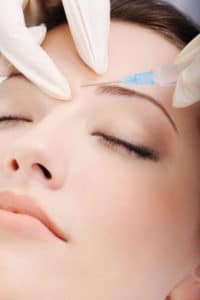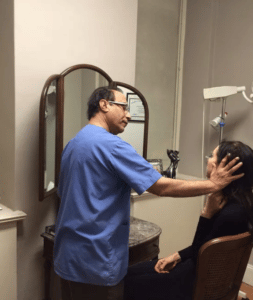There is great confusion today among patients seeking facial aesthetic rejuvenation.

Women in their 30’s-40’s might benefit from such approach; however, as these women age and develop skin laxity and jowls, fillers alone will not adequately rejuvenate her, for several reasons. A youthful face has a triangular shape with the chin serving as the apex of the triangle. Whereas, the aging face has a more rectangular shape.
It is apparent that although filler application to the nasolabial folds and marionette lines might improve them, fillers alone will not convert the rectangular aging look to the more triangular youthful look. Another reason for having a surgical procedure, instead of just fillers, is that usually at this stage, the neck begins to show laxity. No reliable treatments have improved platysma neck bands.
On the other hand, many dermatologists offer deep chemical peels to patients with facial and neck wrinkles, promising them the same results as a facelift, without surgery. It is impossible to achieve a lift by a peel alone. The small lifting effect of the jowls after a deep chemical peel is temporary. Following a deep chemical peel, the facial skin loses its pigmentation, without improving the deep lines, leaving the neck laxity and bands that need to be corrected. The patients, undergoing a deep chemical peel, look unnatural with the face that looks much younger than the neck. There is also a sharp demarcation line along the patient’s jaw line, with a pale white color of the face compared to the natural pigmentation of the neck.
Fillers have a place for young women without significant facial skin or muscle laxity. On the other hand, if the patient goes first to a plastic surgeon, she usually will be recommended to have facial surgery if she has skin and muscle laxity, and at the same time fillers, Botox, and chemical peels. In this way, the patient will obtain the optimal results she is seeking and the surgeon can meet her expectations. Today, surgery of the face is moving towards a more conservative approach with minimal incisions, a quick return to work, and long lasting natural results.
With regard to potential complications, that might appear with surgery as well as fillers. So this is not a reason to prefer one over the other. It is advisable for prospective patients to have a consultation with a plastic surgeon who has the knowledge and expertise to offer them the optimal results.
Non-Surgical Facial Rejuvenation
In recent years, cosmetic enhancement has been growing in popularity. Nearly 11 million surgical and non-surgical cosmetic procedures were performed in the United States alone; 1 million of these procedures were performed on men. The incidence of non-surgical procedures increases every year at a much higher rate than surgical procedures. This has led to a more conservative approach in surgical rejuvenation of the face.
Although non-surgical procedures, such filler and injectables, are appropriate for younger patient with early signs of aging, it cannot replace surgery for more advanced signs of aging. Changes in the face are due to the long term effects of gravity, loss of volume (in fat, muscle and bone), and changes in the skin due to muscle activity and loss of elasticity. After the age of 20, the skin loses 1%-2% of elastic fibers each year. In order to achieve optimal results, there is a need for a combined approach of surgery first and after recovery, additional non-surgical procedures, such as filler, injectables, and chemical peels.
The goal of cosmetic rejuvenation is a restoration of volume and symmetry. Each part of the face must be proportional and in harmony. A youthful look requires a triangular shape with the chin as the apex of the face. When the jowls become prominent with age, converting the triangular youthful look into a rectangular shape, the only way to restore this change is through a surgical procedure.
Fillers
Fillers are used to fill depressions in the forehead, nasojugular groove, scars, nasolabial folds, marionette lines, and for augmenting the cheeks, jaw lines and chin. There are two groups of fillers: one is biodegradable, and the other is permanent.
The biodegradable fillers are temporary and may last up to one year. There are many types of fillers on the market that are used in Europe and other countries, but only a few of them have been tested for safety and approved by the FDA. The most common are hyaluronic acid derivatives that are monologous in structure, meaning it is a substance already present in the body, and therefore, there is no need for allergy testing. Those approved by the FDA, such as Restylane, Restylane Lyft, and Juvederm are being extensively used. They have completely replaced collagen. Collagen required allergy testing and the results were very short-lived.
The permanent fillers include silicone, Gortex, and Bellafill. Since they are foreign material, they can carry the risk of reaction with granuloma formation and lumpiness.
There is an intermediate group of fillers that include Radiesse and Sculptra that possess a slower process of degradation and therefore last longer than a year. Another alternative is the fat graft that has recently become more popular since a larger volume of replacements can be performed. If this procedure is done correctly, it may last for many years.
Evaluation

Next to take place, is the aesthetic evaluation to fully address the patient’s concerns. The area to be injected needs to be marked and shown to the patient before the injection. Pre-injection photographs are mandatory. The plan of treatment will address improving signs of aging, or improving the aesthetic look by correcting proportions and restoring harmony and balance to the face, or both.
In my analysis, I personally prefer to show the patient what he or she needs to look his or her best (whether surgical or non-surgical treatments) and then to carefully listen to the patient’s concerns. If I feel that the treatment for the patient’s concerns will provide minimal change, I discourage the patient from proceeding forward with the treatments. As an expert, it is my responsibility to offer the right procedures and the right filler or injectables to my patients.

